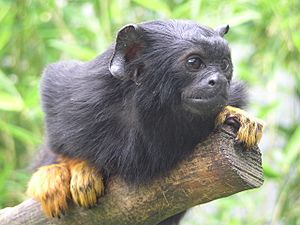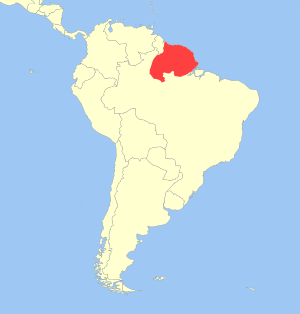Golden-handed tamarin facts for kids
Quick facts for kids Golden-handed tamarin |
|
|---|---|
 |
|
| Conservation status | |
| Scientific classification | |
| Genus: |
Saguinus
|
| Species: |
midas
|
 |
|
| Geographic range in South America | |
| Synonyms | |
|
Simia midas Linnaeus, 1758 |
|
The golden-handed tamarin (Saguinus midas) is a small, active monkey. It is also known as the red-handed tamarin or Midas tamarin. This monkey belongs to a group called New World monkeys, which are found in Central and South America.
Contents
Where Do Golden-Handed Tamarins Live?
Golden-handed tamarins live in the forests of South America. You can find them north of the Amazon River in countries like Brazil, Guyana, French Guiana, and Suriname. They might also live in Venezuela.
These tamarins like to live in trees with smaller tops. They are very good at climbing and spend most of their time high up in the branches.
What Do Golden-Handed Tamarins Look Like?
The golden-handed tamarin is a small monkey. Its body is about 20.5 to 28 centimeters (8 to 11 inches) long. If you include its tail, it can be 31 to 44 centimeters (12 to 17 inches) long! These tamarins weigh about 400 to 550 grams (0.9 to 1.2 pounds).
Their fur is usually dark brown or black. But their hands and feet are a bright golden-orange color. This is how they get their name! Their face is dark and doesn't have much hair. They also have big ears that stick out from their fur.
Like other marmosets, golden-handed tamarins have claws instead of nails on their fingers and toes. The only exception is their big toe, which has a nail. Also, their thumb cannot touch their other fingers, which is different from humans.
Golden-Handed Tamarin Life and Habits
Golden-handed tamarins usually live for about 10 years in the wild. If they live in zoos, they can live even longer, up to 16 years.
Social Life and Family
These tamarins live in groups of 4 to 15 members. They are very cooperative, meaning they work together. There isn't much fighting within the group, even among the males who can have babies.
Young tamarins become adults when they are about 16 to 20 months old. In a group, usually only one female will have babies during the breeding season. The other females in the group somehow stop themselves from having babies.
A mother tamarin is pregnant for about 140 to 170 days. She usually gives birth to two babies at a time. The father tamarin takes care of the young ones most of the time. He only gives them to the mother when they need to drink milk. The whole group helps to care for the young tamarins. If one tamarin is in danger, the others will quickly come to help defend it.
Movement and Diet
Golden-handed tamarins are amazing climbers. They spend most of their time moving through vines and branches in the trees. They are very fast and can jump incredibly well. They are known to jump more than 18 meters (60 feet) from a tree to the ground without getting hurt!
These monkeys eat many different things, so they are called omnivores. Their diet includes leaves, tree sap, fruits, and flowers. They also eat eggs, insects, spiders, frogs, lizards, and nectar from flowers.
Who Are Their Predators?
In the wild, golden-handed tamarins have natural enemies. These include small wild cats, birds of prey (like eagles or hawks), and snakes. To protect themselves, they can be aggressive. They have sharp canine teeth and claws, which they use for defense.
See also
 In Spanish: Tamarino midas para niños
In Spanish: Tamarino midas para niños



